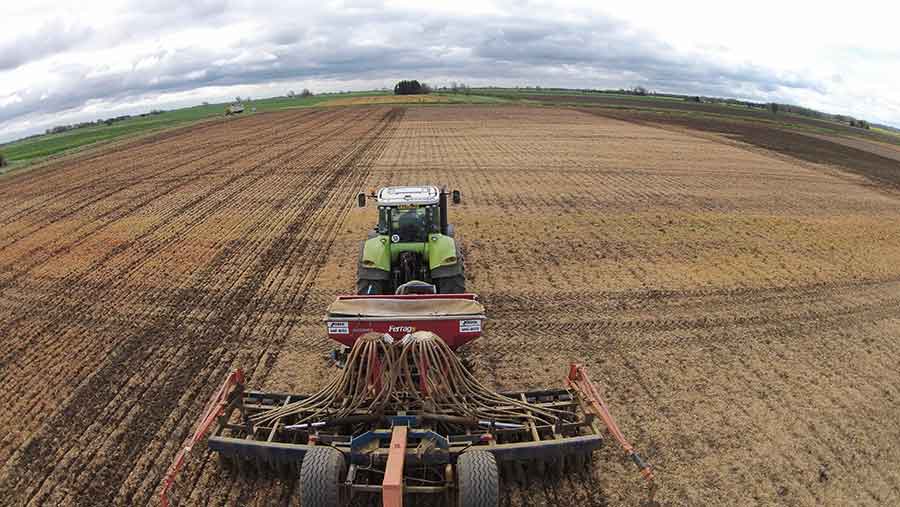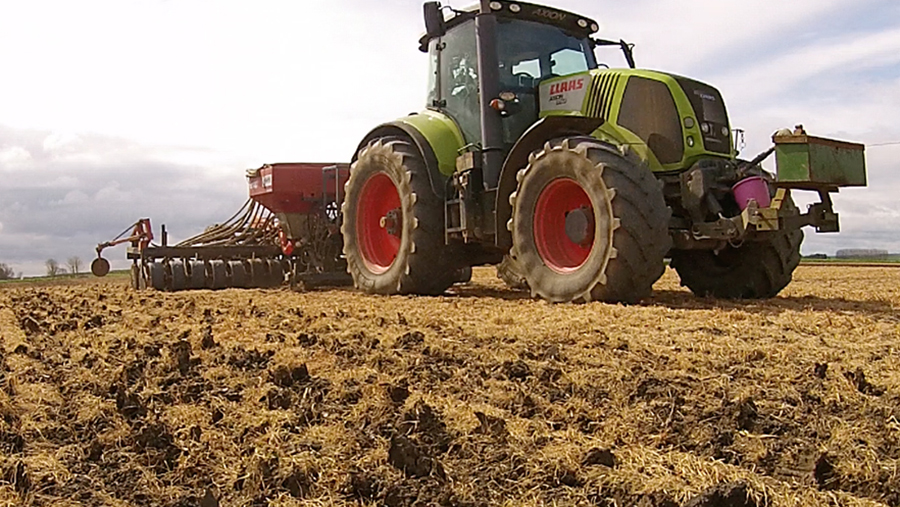Video: Fens blackgrass trial shows need for radical rethink
 © Alex Richardson
© Alex Richardson Growers need to get radical to curb blackgrass. This was the initial observation from a heavy land trial investigating the level of grassweed control achieved with various cultivation, spring cereal and cover crop combinations.
Herbicide-resistant blackgrass dominates grower Chris Richardson’s 400ha family farm on the Lincolnshire Fens and a drop-off in wheat yields has now forced a major shake-up to revive prospects.
Last autumn, Mr Richardson’s son, Farmacy agronomist Alex Richardson, began a trial on a 12ha field where the blackgrass seed population is estimated to be more than 1,000 seeds/sq m.
See also: Blackgrass-infested Fens grower turns to cultural control methods
The trial field was spilt into sections that were either ploughed or shallow cultivated with tines or discs.
The farm-standard cultivation practice of shallow discs and sub-soiler legs was also included in the comparison.
Fenland blackgrass trial: Video recap
Cultivations

Alex Richardson
Alex Richardson tells Farmers Weekly that the farm’s mainly deep marine clay soils, which lie 16 miles east of Grantham, are ideal for blackgrass germination. This was aided by last year’s wet autumn.
“In the autumn, we had quite a few showers and that favoured germination where blackgrass seed was left near the surface of the seed-bed.
“If it had been a drier season we may not have had as much blackgrass come up on the bare land before cultivations,” he explains.
In cases where blackgrass is making its debut appearance in full force, Mr Richardson says ploughing can help control the weed, but it needs to be done well to ensure the seed is properly buried to a depth that makes it unviable.
Recap: Autumn cultivation and cover-cropping trial map
This map shows how the 12ha field has been divided up for the various cultivations and cover crops. It also shows where barley and wheat was drilled this spring.
Hover over the icons on the map below to view a close-up of that part of the field.
Species performance
- Phacelia: Good overwinter growth, despite being drilled late
- Common vetch: Slow to establish when drilled late and low benefit for cost of seed
- Peas: Established well when drilled late, but intolerant to frost
- Home-saved winter oats: Low seed cost and established well in late conditions, but 80kg/ha seed rate meant it was too thick
- Home-saved spring beans: Dependent on rotation – mild winter resulted in good root nodulation
By contrast, Alex Richardson’s father’s farm has seen many years of cultivation using deep discs and wide sub-soiler legs with big wings.
This has resulted in the blackgrass seed being distributed evenly throughout the soil profile.
This makes bringing the weed burden under control an even more difficult task.
“The idea now is to move towards more shallow cultivation to help manage blackgrass, but we may have to use a low-disturbance sub-soiler leg to manage compaction,” Mr Richardson adds.
Cover crop lessons
The farm’s organic matter content is high at 7% and cover cropping will be used to maintain this, while helping to improve soil structure and natural drainage.
The primary reason for including cover crops in the trial was to investigate their soil-conditioning properties, rather than for blackgrass control.
See also: How to create the perfect blackgrass stale seed-bed
Getting thorough blackgrass control by using stale seed-beds to spray off three flushes of blackgrass in the autumn meant the cover crop mixes were not drilled until mid-September and this led to poor establishment of the more exotic species.
Trialled cover-crop mixes
- Commercial mixes:
- Peas, vetch, bristle oats, clover, phacelia and lupins
- Peas, vetch, buckwheat, clover, serradella and phacelia
- Home-saved mixes:
- Winter oats and common vetch
- Winter oats, spring beans and common vetch
“We wanted to see if it was worth having a lot of different species,” explains Mr Richardson.
“In future I think it is best to tailor a three-way mix based on the future rotation of the farm and what has performed well when drilling late, because we need good stale seed-beds to help control blackgrass.”
Home-saved species performed well given the delayed drilling, but spring drilling was a victim of the success as cover cropped areas were more difficult to drill.
Cover crop roots held the wet soil open after drilling, leaving a channel for slugs to follow and attack the seed, with poor soil consolidation leading to hampered establishment.
“These areas stayed wet, but a drier spring could have seen a good amount of moisture retained, which would have helped establishment,” he says.
The home-saved winter oats were drilled at 80kg/ha, which Mr Richardson says was too thick. This autumn he plans to try spring oats at 50kg/ha.
He explains that spring oats grow more upright compared with the winter species, which tends to sprawl across the ground, so this may allow wind and sunlight to get into the cover crop and help to dry the soil before drilling.
Spraying off
The trial saw cover-cropped areas sprayed off on three different dates to determine the best timing prior to drilling.
“We sprayed off on 16 and 26 February and also tried a later date of 11 March. We found the February spray timings allowed just enough time before drilling on 8 April.
“The later date meant the soil was still wet, with decaying material present that meant the disc coulter left an open channel with little surface tilth to cover the seed.
“Establishment has been lower in the cover-cropped areas as a result, down to about 30% on the areas sprayed off in March compared with 60% on the earlier timings.”
Drilling into wet clay soil meant the press wheel struggled to fully close the drilled slots, so a follow-up pass of diagonal cross-rolling was needed to improve seed consolidation.

Spring barley drilling into a cover crop on the Lincolnshire Fens © Alex Richardson
Barley v wheat
Perhaps unsurprisingly, spring barley has proved to be the top performer of the two spring-drilled cereal crops.
Mulika spring wheat and Explorer spring barley were drilled at three rates: 350, 450 and 550 seeds/sq m.
“Spring barley will be used next year because it is just better at smothering the blackgrass compared with spring wheat, and we will go with the highest seed rate to get the best control possible,” says Mr Richardson.
When it comes to spring blackgrass germination, the findings suggest cover-cropped areas saw less weed emergence.
Mr Richardson thinks this is because the network of cover-crop roots held the soil together at drilling which, although crop establishment was hindered, it did mean there was less soil cracking and therefore less stimulation to germinate.
“We got lower crop establishment, but lower blackgrass germination too. Blackgrass head counts at the end of June will give the final picture of the success of each option. This will be just as important as final yield.”


